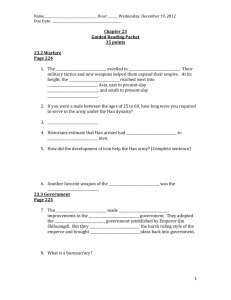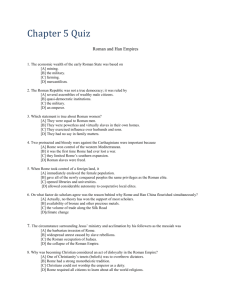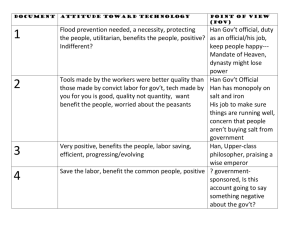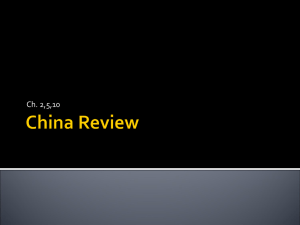China
advertisement
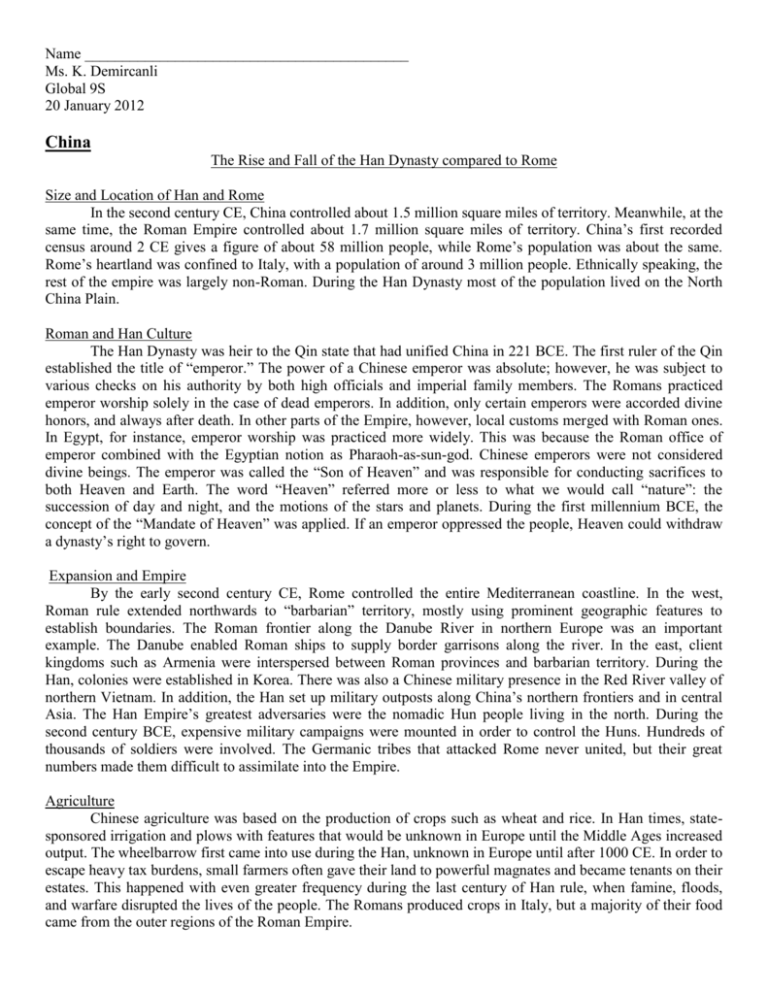
Name ___________________________________________ Ms. K. Demircanli Global 9S 20 January 2012 China The Rise and Fall of the Han Dynasty compared to Rome Size and Location of Han and Rome In the second century CE, China controlled about 1.5 million square miles of territory. Meanwhile, at the same time, the Roman Empire controlled about 1.7 million square miles of territory. China’s first recorded census around 2 CE gives a figure of about 58 million people, while Rome’s population was about the same. Rome’s heartland was confined to Italy, with a population of around 3 million people. Ethnically speaking, the rest of the empire was largely non-Roman. During the Han Dynasty most of the population lived on the North China Plain. Roman and Han Culture The Han Dynasty was heir to the Qin state that had unified China in 221 BCE. The first ruler of the Qin established the title of “emperor.” The power of a Chinese emperor was absolute; however, he was subject to various checks on his authority by both high officials and imperial family members. The Romans practiced emperor worship solely in the case of dead emperors. In addition, only certain emperors were accorded divine honors, and always after death. In other parts of the Empire, however, local customs merged with Roman ones. In Egypt, for instance, emperor worship was practiced more widely. This was because the Roman office of emperor combined with the Egyptian notion as Pharaoh-as-sun-god. Chinese emperors were not considered divine beings. The emperor was called the “Son of Heaven” and was responsible for conducting sacrifices to both Heaven and Earth. The word “Heaven” referred more or less to what we would call “nature”: the succession of day and night, and the motions of the stars and planets. During the first millennium BCE, the concept of the “Mandate of Heaven” was applied. If an emperor oppressed the people, Heaven could withdraw a dynasty’s right to govern. Expansion and Empire By the early second century CE, Rome controlled the entire Mediterranean coastline. In the west, Roman rule extended northwards to “barbarian” territory, mostly using prominent geographic features to establish boundaries. The Roman frontier along the Danube River in northern Europe was an important example. The Danube enabled Roman ships to supply border garrisons along the river. In the east, client kingdoms such as Armenia were interspersed between Roman provinces and barbarian territory. During the Han, colonies were established in Korea. There was also a Chinese military presence in the Red River valley of northern Vietnam. In addition, the Han set up military outposts along China’s northern frontiers and in central Asia. The Han Empire’s greatest adversaries were the nomadic Hun people living in the north. During the second century BCE, expensive military campaigns were mounted in order to control the Huns. Hundreds of thousands of soldiers were involved. The Germanic tribes that attacked Rome never united, but their great numbers made them difficult to assimilate into the Empire. Agriculture Chinese agriculture was based on the production of crops such as wheat and rice. In Han times, statesponsored irrigation and plows with features that would be unknown in Europe until the Middle Ages increased output. The wheelbarrow first came into use during the Han, unknown in Europe until after 1000 CE. In order to escape heavy tax burdens, small farmers often gave their land to powerful magnates and became tenants on their estates. This happened with even greater frequency during the last century of Han rule, when famine, floods, and warfare disrupted the lives of the people. The Romans produced crops in Italy, but a majority of their food came from the outer regions of the Roman Empire. Trade Trade was always considered a second-rate occupation compared to landholding, although it was practiced in all periods of Roman history. Senators were strictly forbidden from participating in commerce, but devised ways to get around the prohibition. Some provinces specialized in the production of certain goods but most of the Empire was independent, divided into self-sufficient agricultural units. Trade in luxuries such as silk and spices were mainly confined to providing for the elite. Silk imported across Central Asia from China was coveted by the Roman upper classes. The government’s interest in the movement of goods was confined to grain and other supplies for the city of Rome and for army units stationed throughout the Empire. The “grain dole” for the common people was an essential element of domestic policy. In China, agriculture was called the “fundamental occupation.” Trade, by contrast, was officially disparaged. Merchants amassed fortunes but were looked upon as people whose wealth enabled them to transgress social boundaries. The Han government instituted monopolies on key products such as salt and iron that impeded the growth of private enterprise. Religion and Philosophy The Han Dynasty adopted Confucianism as state orthodoxy. Its values, particularly the importance attached to filial piety, helped link central government to both local elites and the common people. In addition, the idea that human beings were part of an orderly, interconnected universe, and that good government echoed the regular workings of such a universe, cemented the notion of a single shared world—what the Chinese called “All-Under-Heaven.” Although these values became widespread, they never totally replaced local beliefs based on folklore, magic, and age-old custom. Rome was culturally pluralistic. The diverse societies that Rome colonized would eventually take part in creating the map of early medieval Europe. Social Classes The Roman elite were a landed gentry living on the income provided by their estates. They dominated society and staffed the government of the Empire. Roman society placed a great value on loyalty both to family and to the state. A member of the elite was constantly exhorted to be mindful of his father’s and grandfather’s achievements and, if possible, to exceed them. At a Roman funeral, ancestors’ masks were displayed and their deeds described and praised. Individuals could win honor only in the context of public service. During the second and first centuries BCE, most of the magistrates and members of the Senate came from the same core of noble families who controlled it. Early Chinese thinkers divided society into four social classes: the literate elite who served as government bureaucrats, farmers, merchants, and craftsmen. The vast majority of the population was farmers. During the Han, social prestige and political power became closely associated with Confucian values and learning. The Confucian classics became the standard for public and private behavior. Filial piety—the respect and obedience owed to parents by their children—was at the core of the Confucian value system. These values remained unchallenged until the early twentieth century. The Han was a large empire and required a bureaucracy to govern it. Official posts were filled in a variety of ways. Although people in government service could recommend relatives for office, it was also possible for those who didn’t come from official families to obtain posts. In Confucian terms, the ideals governing class was based on merit rather than birth or wealth. The Han Dynasty Declines The Emperor Wu Ti’s conquests led to a fiscal crisis. As costs increased, taxes increased, and the peasants’ burdens led to revolt. The end result was that the central government had to rely more on local military commanders and great landowners for control of the population, giving them great power and prestige as its own expense. The cycle of decline after an initial period of increasing prosperity and power has been the pattern of all Chinese dynasties. During the Han, this “dynastic cycle” as Western historians of China call it, led to a succession of mediocre rulers after Wu Ti’s death and a temporary user action of the throne (9-23 CE), which divided the Earlier from the Later Han. Wang Mang, united Confucian humanitarianism with Legalist practice. Like his contemporary in the West, the Roman Emperor Augustus, his goal was the rejuvenation of society. By Wang Mang’s day the number of large tax-free estates had greatly increased while the number of tax-paying peasant holdings had declined. This was a byproduct of the private landownership that, under the Qin, had replaced the old communal use of land. Rich officials and merchants were able to acquire the lands of small peasant-owners, who became tenants paying exorbitant rents. The conflict of landownership and tenancy, along with the concentration of power of great families, became a major problem in Chinese history. More and more peasants fell behind in their rents and were forced to sell themselves or their children into debt slavery. To remedy this situation and increase the government’s tax income, Wang Mang decreed that the land was the property of the nation and should be portioned out to peasant families, who would pay taxes on their allotments. Wang Mang sought to solve the long-standing problem of inflation, which had greatly increased since Wu Ti first began debasing the coinage when he found himself in financial difficulties, by setting maximum prices on basic commodities. He also sought to stabilize prices by instituting “leveling” the government bought surplus commodities when prices fell and sold them when scarcity caused prices to rise. Wang Mang’s remarkable reform program failed, however, officials bungled the difficult administrative task, and the powerful landowners rebelled against the ruler who proposed to confiscate their land. Although Wang Mang rescinded his reforms, he was killed by rebels in 23 CE. The Final Fall of the Han The Later Han Dynasty never reached the heights of its predecessor. Warlords who were members of the rich landowner classes seized more and more power, and widespread peasant rebellions sapped the state’s resources. Surviving in name only during its last thirty years, the Han Dynasty ended in 220 CE, when the throne was usurped by the son of a famous warlord. Three and a half centuries of disunity and turbulence followed- the longest in China’s long history and often called China’s “Middle Ages”—as it did in Europe after the fall of the Roman Empire. But China eventually succeeded where Europe failed, in 589 CE China was once again united by the Sui Dynasty. With minor exceptions, it has remained united until this day. The Han Dynasty and the Roman Empire are commonly compared for many reasons. In the chart below discuss the most valuable similarities and differences between Han and Rome. Han Dynasty 1. Size and Location 2. Culture 3. Expansion and Empire 4. Agriculture 5. Trade 6. Religion and Phil Philosophy 7. Social Classes 8. Decline and Fall Roman Empire


